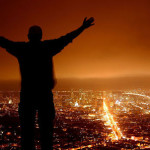We run our website the way we wished the whole internet worked: we provide high quality original content with no ads. We are funded solely by your direct support. Please consider supporting this project.

Caught Between Two Conflicting Truths
In my previous blog I tried to show that adopting a “Christocentric” approach to Scripture isn’t adequate, as evidenced by the fact that people adopting this approach often come to radically different conclusions. In fact, it seems to me that the “Christocentric” label is often close to meaningless inasmuch as it doesn’t meaningfully contrast with anything. If a “Christocentric” perspective doesn’t conflict with the portrait of God commanding his people to murder every last woman and child while threatening to punish anyone who shows mercy, then honestly, what does the label even mean? To remedy this, I proposed that we adopt a cross-centered approach, arguing that this sharper focus is justified inasmuch as the cross is the thematic center of everything Jesus was about.
I’d now like to begin unpacking some of the implications of this cross-centered approach to Scripture. And a good place to begin is with the genocidal portrait of God I just mentioned. While some may imagine that a Christocentric view of God doesn’t rule out God commanding the merciless murder of women and infants, I submit that a cruciform portrait of God certainly does. Jesus reveals a God who chose to refrain from using his power to crush enemies and chose instead to give his life for them. And he reveals a God who taught us, and modeled for us, a completely non-violent, loving, servant way of responding to hostile enemies.
But this immediately presents us with a problem. Throughout the Gospels, Jesus expresses absolute confidence in the OT as the Word of God. In fact, a number of scholars have argued that this conviction lies at the heart of Jesus’ self-understanding. While I don’t believe Jesus was omniscient while on earth, I find it impossible to confess him as Lord while correcting his theology, especially about such a foundational matter. He once asked, “Why do you call me ‘Lord’ when you don’t do the things that I say?” I think he could have made a similar point by asking, “Why do you call me ‘Lord” when you don’t believe the things I teach?” And one of the things Jesus taught was that the OT is the Word of God!
Not only this, but going back to the apostle Paul, the Church has always understood Scripture to be “God-breathed” (1 Tim. 3:16) – a conviction that came to be applied to Paul himself along with the other NT authors from the second century on. While I don’t regard Church tradition to be infallible, it certainly carries a great deal of weight, especially on matters as foundational as this one, on matters that go back to the very beginning of the church’s existence, and on matters such as this one about which there has never been any significant disagreement. When the church’s uniform view of Scripture is combined with the authority of Christ, I find I am compelled to accept that all Scripture – including its multitude of horrific portraits of God – are “God-breathed.”
So I find myself awkwardly caught between two seemingly contradictory yet equally non-negotiable truths. On the one hand, I feel compelled to confess that God looks like Jesus, choosing to die for enemies and at the hands of enemies rather than use his power to crush them. On the other hand, I feel compelled to confess that all Scripture is God-breathed, including its portraits of God that look antithetical to the God who died on a cross for his enemies.
What are we to do?
Stay tuned.
_____
Note: This article was originally published on the temporary blog Greg used prior to the launch of ReKnew.org.
Image by Quinn Dombrowski. Used in accordance with Creative Commons. Sourced via Flickr.
Category: General
Tags: Cruciform Theology, Jesus, Old Testament, Scripture, Violence
Related Reading

What To Do With the Violent God of the Old Testament
For eight years Greg has been researching for and writing the book entitled The Crucifixion of the Warrior God. In it he confronts the commonly held idea that the Old Testament depictions of God behaving violently should be held alongside of and equal to the God revealed through Jesus dying on the cross. But if the Old Testament…

An Alternative to Biblical Inerrancy
As with all other theological issues, when it comes to affirming that Scripture is “God-breathed,” everything hangs on where one starts. A dominant strand of the Evangelical tradition started with the assumption that, if God is perfect, and if Scripture is “God-breathed,” then Scripture must also be perfect or “inerrant.” Other “progressive” evangelicals have responded by…

Jesus, the Word of God
“[T]he standing message of the Fathers to the Church Universal,” writes Georges Florovsky, was that “Christ Jesus is the Alpha and Omega of the Scriptures both the climax and the knot of the Bible.”[1] It was also unquestionably one of the most foundational theological assumptions of Luther and Calvin as well as other Reformers. Hence,…

Do the Gospels Promote Anti-Semitism?
Over the last couple of weeks we have been looking at various passages from the Gospels that have been used by some to argue that Jesus condones violence. Here is a link to each of them: The Cleansing of the Temple and Non-Violence Was Jesus Unloving Toward the Pharisees? Violent Parables? Why Did Jesus Curse…

The Longing of Advent
The Advent season is a time of anticipating the coming of God, in Christ, a time of turning our imagination toward the revelation of God’s love for us. This after all is the deepest longing of our heart, and our natural longings always point us to something real. We grow hungry only because there’s such…

What is the Kingdom of God (Part 1)
We all know what the Kingdom of God is, right? But this is precisely the problem. Since we are all to a large extent products of our culture, what seems obviously true and right to us will be at least influenced, if not determined, by what seems obviously true and right to our culture. This,…
